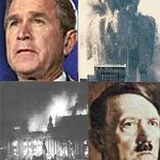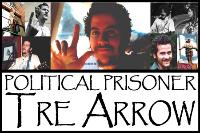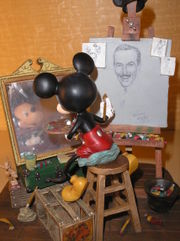Sunday, March 23
CEO Fingers Wall Street-Mafia Stock Scheme; Evokes John McCain's 80s-Era Role in Democrats' S&L Scandal
"I've been looking at ["naked short selling" of stocks] for two years, and I'm pretty much convinced this is the single biggest scandal in the history of American journalism," said [Mark] Mitchell, a former financial writer for Time magazine.... "You don't have to dig very far into this before you get to organized crime." --Daily Utah Chronicle, 5 March 2008
Since the Enron Corporation imploded, Americans have gotten quite an education in the corporate chicanery, accounting gimmickry, Wall Street scams, and feckless regulation that helped sustain the roaring 1990s stock market. --The American Prospect, "Plan to Lose Money," 1 July 2002
If anyone could turn over the stones of Wall Street's current markets and credit "panics" and look honestly into the vermin there, they would discover another elite Big Money scam foisted on America by its high priests of investment, yet another shell game to separate us hick rubes from our dollars.
 Earlier this month Patrick Byrne (right), a CEO in Utah who founded Salt Lake City-based Overstock.com, outlined one Wall Street stock scam for a University of Utah audience he calls "naked short selling." According to Daily Utah Chronicle staff writer Dan Treasure
Earlier this month Patrick Byrne (right), a CEO in Utah who founded Salt Lake City-based Overstock.com, outlined one Wall Street stock scam for a University of Utah audience he calls "naked short selling." According to Daily Utah Chronicle staff writer Dan Treasure
Mitchell's is a remarkable statement, given the scope of ongoing Wall Street investment scams--with complicity of New York organized crime families--that skim "billions of dollars a year" from investors.
But Wall Street's 1980s Savings and Loan mortgage scandal provides the historical perspective to understand the current scam foisted by the financial high priests on unsuspecting Americans. That money vaporizing scheme threw thousands out of their homes while leaving the rest of us a bailout bill estimated at "$32 billion a year for 30 years."
 Robert Corson, who helped the CIA smuggle and launder money, bought Kleburg County Savings and Loan and bankrupted it in nine months. Houston Post reporter Pete Brewton found 24 failed S&Ls with ties to the ClA. One of these was Peoples Savings and Loan in Llano, Texas, which loaned $3 million to Ray Corona, a drug smuggler, and $2.3 million to his associate Harold White. [emphasis added]
Robert Corson, who helped the CIA smuggle and launder money, bought Kleburg County Savings and Loan and bankrupted it in nine months. Houston Post reporter Pete Brewton found 24 failed S&Ls with ties to the ClA. One of these was Peoples Savings and Loan in Llano, Texas, which loaned $3 million to Ray Corona, a drug smuggler, and $2.3 million to his associate Harold White. [emphasis added]
In 1989, presidential candidate John McCain was the only Republican among five US Senators initially charged with interfering with a federal probe into indicted owner Charles Keating's Irvine, California-based Lincoln Savings and Loan, although the Arizona Senator's involvement was subsequently reduced to "questionable conduct."
Since the Enron Corporation imploded, Americans have gotten quite an education in the corporate chicanery, accounting gimmickry, Wall Street scams, and feckless regulation that helped sustain the roaring 1990s stock market. --The American Prospect, "Plan to Lose Money," 1 July 2002
If anyone could turn over the stones of Wall Street's current markets and credit "panics" and look honestly into the vermin there, they would discover another elite Big Money scam foisted on America by its high priests of investment, yet another shell game to separate us hick rubes from our dollars.
 Earlier this month Patrick Byrne (right), a CEO in Utah who founded Salt Lake City-based Overstock.com, outlined one Wall Street stock scam for a University of Utah audience he calls "naked short selling." According to Daily Utah Chronicle staff writer Dan Treasure
Earlier this month Patrick Byrne (right), a CEO in Utah who founded Salt Lake City-based Overstock.com, outlined one Wall Street stock scam for a University of Utah audience he calls "naked short selling." According to Daily Utah Chronicle staff writer Dan TreasureEvery day, thousands of Americans look to invest their money in stocks, and many of them go through brokers and traders to simplify the process.Democrat Congress Abets Wall Street in 80s-Era S&L Scandal
Unfortunately, according to Overstock.com CEO Patrick Byrne, a majority of those purchasers will be victims of Wall Street's criminal tactics and will help line the pockets of corrupt brokers and lawyers. Byrne, a Utahn who founded Overstock.com, talked to a crowd in the Union on Monday about how New York financial media and law firms have teamed up with big-wig business elites to create massive amounts of profit at the cost of American consumers.
Byrne said when someone purchases a stock, there is a three-day stock settlement period during which a broker or a trader must provide a purchaser with that stock. However, through loopholes in the system, brokers and traders can legally not provide you with that stock almost indefinitely, giving the purchaser an IOU instead, Byrne said.
"It's my thesis that certain people have figured out how they can abuse that loophole, and flood the market...often in connivance with a broker dealer," he said.
Through this "flooding," the brokers can essentially issue the same stock to hundreds of people at no penalty. By increasing the supply of stocks, these dealers can dramatically drop the price according to the laws of supply and demand.
Byrne showed how the "cheating parties" make money off of a stock price dropping through a process called "naked short selling."
In brief, Byrne showed that "naked short selling" occurs when certain hedge funds and broker-dealers flood the market for a particular firm's stock with IOU's for that stock, cracking the market in it. If they ever have to make good on their IOU's it is at fraction of the original price, and they get to pocket the difference.
These methods are used to create huge profits, often killing the victimized corporation in the process, and leaving the purchaser high and dry, Byrne said.
In his efforts to stop this charade, Byrne filed a $3.5 billion lawsuit against Goldman Sachs, Morgan Stanley and nine other well-known brokers. Byrne said numerous publications, including the New York Post and Forbes magazine, have protested his "crusade," painting him as a crazed lunatic who is angry about Overstock.com's own stock price drop. Byrne said the Mafia has become a silent player in the Wall Street game.
"You don't have to dig very far into this before you get to organized crime," he said.
....
Additionally, Byrne remarked on how writer Mark Mitchell was threatened in New York and told to stay away from "the Irish guy," which Byrne believes was himself.
"I've been looking at this for two years, and I'm pretty much convinced this is the single biggest scandal in the history of American journalism," said Mitchell, a former financial writer for Time magazine....
Mitchell's is a remarkable statement, given the scope of ongoing Wall Street investment scams--with complicity of New York organized crime families--that skim "billions of dollars a year" from investors.
But Wall Street's 1980s Savings and Loan mortgage scandal provides the historical perspective to understand the current scam foisted by the financial high priests on unsuspecting Americans. That money vaporizing scheme threw thousands out of their homes while leaving the rest of us a bailout bill estimated at "$32 billion a year for 30 years."
Until the 1930s, [Savings and Loans]... got along quite nicely more or less on their own. But when nearly two thousand of them failed during the Great Depression, the government began regulating them in earnest, and providing deposit insurance to quell fears of further S&L failures.Then in Ronald Reagan's early presidency the Democrat-controlled US House of Representatives provided Volcker and his Rockefeller handlers with critical legislation that left S&L mortgage holders exposed to shady dealers, further permitting continuance of the financial blood bath well beyond reasonable fiscal judgment.
Compared to the greener pastures of the commercial banks, the S&Ls' opportunities for financial chicanery were slight, so there wasn't a great deal of corruption there. The trouble began when Jimmy Carter appointed Paul Volcker chairman of the Federal Reserve Board (commonly called "the Fed") in late 1979.
The Fed is supposed to minimize unemployment as well as inflation, and before 1979, it tried to achieve some sort of balance between the two goals. But under Volcker and his successor, Alan Greenspan, it's simply aimed for low inflation, regardless of the effect that has on jobs. In fact, Greenspan has asked Congress to relieve the Fed of responsibility for keeping unemployment down.
Inflation was high when Volcker took over-13% or so. To get it under control, he tightened the money supply. This brought on a monster recession, the biggest since World War II. Within a year, the prime rate shot up to the unheard-of level of 21.5% (compared to an average of 7.6% for the fourteen previous years). Unemployment peaked at just under 11%.
According to author Robert Sherrill, Volcker stated, upon taking office, that "the standard of living for the average American has to decline." [emphasis added] Sherrill says Volcker was recommended by David Rockefeller because "Wall Street and the international banking fraternity loved [Volcker].
They hated inflation--bankers don't like to be repaid in money that is softer than the money they lend, even if the softer money makes the economy hum--and they knew that Volcker was mean enough to destroy the economy to save the hardness of their dollars."[emphasis added]
Volcker's policies caused a combination of inflation and recession called "stagflation." This put the squeeze on S&Ls. Most S&L mortgages were fixed-rate, so the S&Ls couldn't raise the interest they charged on those.
But because their depositors were withdrawing money by the billions and placing it in higher-yielding money market funds or government bonds, the S&Ls did have to raise the rates they paid on savings accounts and CDs. Finally, because of the recession, homeowners started defaulting on their mortgages in droves, and S&L bankruptcies skyrocketed.
By the time Ronald Reagan took office in 1981, two-thirds of the nation's S&Ls were losing money and many were broke. If all the problem thrifts had been shut down right then, the government's insurance fund would have covered their debts.Mafia money men and drug traffickers joined the Bush clan to exploit unprotected S&L's--like Salt Lake City S&L State Savings.
Instead, the government delayed an average of two years-and, in some cases, as many as seven years-thus allowing bankrupt S&Ls to go on losing billions of dollars. This delay also gave S&Ls a chance to gamble on questionable investments, in an attempt to regain solvency. But first they had to convince Congress to deregulate them.
One night in 1980, Representative Fernand St Germain (D-Rhode Island), whose $10,000-to-$20,000-a-year restaurant and bar tab was paid for by the S&L industry's chief lobbyist, proposed raising federal insurance on S&L savings accounts from $40,000 to $100,000- even though the average size of an S&L account was $6,000. He waited until after midnight, when only eleven representatives were still on the floor of the House; they approved his proposal unanimously.
But St Germain was just getting warmed up. In 1982, he cosponsored a bill that removed all controls on what S&Ls could charge for interest and released them from their century-old reliance on home mortgages.
Around the same time, the Reagan administration ended the requirement that S&Ls lend money only in their own communities, allowed them to offer 100% financing (i.e. no down payments), let real estate developers own their own S&Ls, and permitted S&L owners to lend money to themselves.
These changes were like taping a sign to the S&Ls' backs that read, "Defraud me." In fact, it's widely rumored that Mafia lawyers and accountants carefully monitored the progress of this bill as it worked its way through Congress, ready to pounce the moment it became law.The Central Intelligence Agency --characterized in the critically-acclaimed 1992 book The Old Boys: The American Elite and the Origins of the CIA as originating among "a self-interested assortment of Wall Street bankers and lawyers"--eagerly joined the feeding frenzy on Middle America, in part to help pay for Iran-Contra arms shipment throughout the Reagan presidency (1981-1989).
J. William Oidenburg bought State Savings of Salt Lake City for $10.5 million, then had it pay him $55 million for a piece of land he'd bought for $874,000.
With the help of a shadowy figure named Herman K. Beebe, who served a year for bank fraud, Don Dixon bought Vernon Savings and Loan-one of the nation's healthiest-then set up a series of corporations for it to loan money to. Four years later, he left Vernon $1.3 billion in debt.
Beebe also had money in Silverado Savings, an S&L partly owned by President Bush's son Neil. [emphasis added] Silverado told a prospective borrower he couldn't have $10 million; instead, he should borrow $15 million and buy $5 million in Silverado stock.
Although federal examiners knew Silverado was leaking cash as early as 1985, it wasn't closed down until December 1988, a month after Bush was elected president. Because Silverado kept leaking cash for those three years, it ended up costing taxpayers more than a billion dollars.
 Robert Corson, who helped the CIA smuggle and launder money, bought Kleburg County Savings and Loan and bankrupted it in nine months. Houston Post reporter Pete Brewton found 24 failed S&Ls with ties to the ClA. One of these was Peoples Savings and Loan in Llano, Texas, which loaned $3 million to Ray Corona, a drug smuggler, and $2.3 million to his associate Harold White. [emphasis added]
Robert Corson, who helped the CIA smuggle and launder money, bought Kleburg County Savings and Loan and bankrupted it in nine months. Houston Post reporter Pete Brewton found 24 failed S&Ls with ties to the ClA. One of these was Peoples Savings and Loan in Llano, Texas, which loaned $3 million to Ray Corona, a drug smuggler, and $2.3 million to his associate Harold White. [emphasis added]One of Corona's drug-smuggling associates was Frank Castro, a Cuban exile involved in Oliver North's contra resupply network. Herman Beebe's Palmer National Bank was also involved with North; it loaned money to customers who then channeled it to the Swiss bank accounts used to supply the contras.Rather than seen for what, in fact, it was--a systematically coordinated heist of Middle America--the official characterization of the S&L debacle--$500 billion in stolen funds combined with the $960 billion taxpayer bailout--was "mindless blundering."
The Reagan administration not only failed to police the industry while all this was going on, it dreamt up ways to keep insolvent S&Ls propped up even longer. By 1988, the government was spending a billion dollars a month keeping "zombie thrifts" afloat.
Everyone in the S&L industry and Congress knew that a bailout would be necessary, but a conspiracy of silence kept the issue out of public debate. Democratic presidential candidate Michael Dukakis tried to raise the issue in 1988, but dropped it under pressure from his running mate, Lloyd Bentsen (who had been part-owner of a couple of Texas S&Ls).
The authors of the best book on the S&L scandal, Inside Job [: The Looting of America's Savings and Loans], conclude that, rather than a lot of mindless blundering, there was "some kind of network...a purposeful and coordinated system of fraud. At each step of our investigation our suspicions grew because, of the dozens of savings and loans we investigated, we never once examined a thrift-no matter how random the choice- without finding someone there we already knew from another failed S&L."Citizen McCain: Bullet Dodger
In 1989, presidential candidate John McCain was the only Republican among five US Senators initially charged with interfering with a federal probe into indicted owner Charles Keating's Irvine, California-based Lincoln Savings and Loan, although the Arizona Senator's involvement was subsequently reduced to "questionable conduct."
In October 1989 The Arizona Republic reported that in addition to campaign contributions, McCain's wife and her father had invested $359,100 in a Keating shopping center in April 1986, a year before McCain met with the regulators. The paper also reported that the McCains, sometimes accompanied by their daughter and baby-sitter, had made at least nine trips at Keating's expense, sometimes aboard the American Continental jet. Three of the trips were made during vacations to Keating's opulent Bahamas retreat at Cat Cay. McCain also did not pay Keating for some of the trips until years after they were taken, after he learned that Keating was in trouble over Lincoln. Lincoln Savings and Loan's collapse is said to have cost taxpayers $3.4 billion.Keating was the only S&L raider to do prison time. In January 2008, the New York Times revisited GOP presidential aspirate McCain's involvement in the scandal:
After 1999, the only member of the Keating Five remaining in the U.S. Senate was John McCain, who is the Republican candidate in the 2008 U.S. presidential election. Before McCain was named the presumptive nominee, The New York Times ran an article on January 28, 2008 revisiting the scandal in addition to some other allegations of inappropriate behavior by McCain. Robert S. Bennett, whom McCain had hired to represent him in this matter, defended McCain's character and was one of many people who criticized the piece. Bennett, who was the special investigator during the Keating Five scandal that The Times revisited in the article, said that he fully investigated McCain back then and suggested to the Senate Ethics Committee to not pursue charges against McCain because of "no evidence against him." Bennett was coincidentally on Hannity and Colmes the night the story broke to talk about his autobiography. On the show, he said that he felt the Committee pursued charges against McCain because, without him, the case would have been entirely against Democrats.












